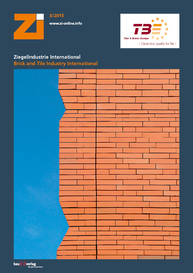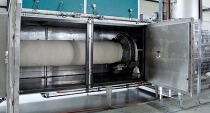Syngas for sustainable brick production
1 Context
The brick and tile industry fires its products in a high-temperature process. The large quantities of fossil fuel needed to cover the heat requirements of the kilns emit carbon dioxide as an anthropogenic greenhouse gas. The sectoral release of CO2 can, however, be reduced by means including the increased use of solid biomass. For this to function properly at brickmaking plants, the solid fuels in question must first be subjected to a gasification process, because their direct combustion could cause changes in the colour and structure of the brick surfaces, hence impairing their quality.
2 Objectives
Within this Cornet project, the German partner, IZF, was responsible for conducting experiments on the use of synthetic gas (syngas) in a laboratory furnace. The goal of these experiments was to determine the effects of the altered firing-space gas atmosphere on product characteristics and possible changes in specific energy consumption. In addition, how syngas can impact the design of burners and their requisite control behaviour was also investigated.
The Austrian project partner was tasked with ascertaining the legal/regulatory framework and establishing the availability of alternative fuels.
3 Procedure and findings
With a view to achieving the prescribed project objectives, various masonry bricks, engineering bricks, facing bricks and roof tiles with diverse finishes were tested. The products were fired using natural gas and two different types of syngas.
In contrast to the project‘s planning base, it was not possible to ensure continuous operation of the syngas plant. Consequently, samples of gas were taken and analysed in the course of intermittent operation to enable distinguishment of the feedstock-specific gas composition and fuel value (»Table 1).
As »Table 1 indicates, the composition of the syngas depends on the employed type of feedstock. In order to obtain two different gas compositions, a number of synthetic gases based on different starting materials were analysed. The experiments were performed separately for syngas obtained from sewage sludge and from municipal solid waste. »Table 2 compares the compositions of syngas (both types) and natural gas.
The products were fired according to their original firing curves. In other words, not only was the firing time identical, but both the maximum temperature and the time at maturing temperature were simulated to reflect an actual operating environment. The typical product characteristics, i.e., compressive strength, specific gravity, water absorption, etc. were analysed, as was the impact on the colour of the roof tiles (natural red, engobed and glazed). None of the tests showed the different types of fuel gas to have any effect on product characteristics.
However, the specific energy consumption was found to have been affected. The use of synthetic gas lowered the specific energy consumption to below that of firings with natural gas, whereas dependence on the carbon monoxide concentration in the fuel gas was determined.
Cornet stands for Collective Research Networking, that is, for the cross-linkage of national and regional collective research programmes in Europe. As of this writing, ministries and project executing organizations from seven different countries and regions are participating in this AiF-coordinated Cornet network, the goal of which is to intensify cooperation between national and regional collective research programmes.
Cornet project 70EN, as conducted by the Research Association Brick and Tile Industry, received German-partner funding from the Federal Ministry for Economic Affairs and Energy, via AiF.
The 206-page final report is available from Research Alliance of the Brick and Tile Industry Regd (FGZ).






